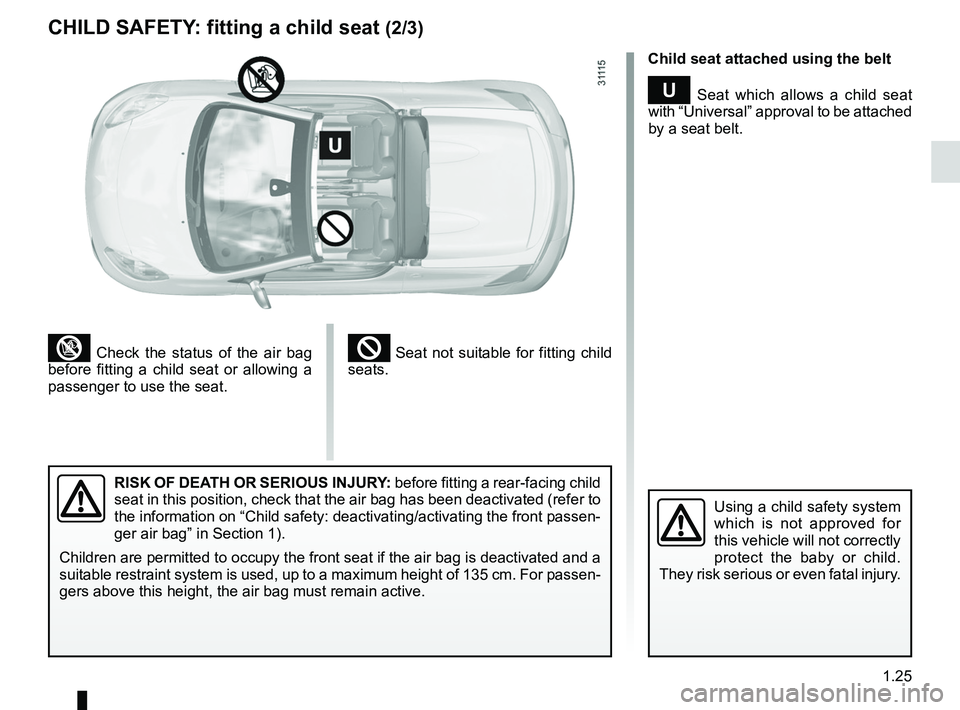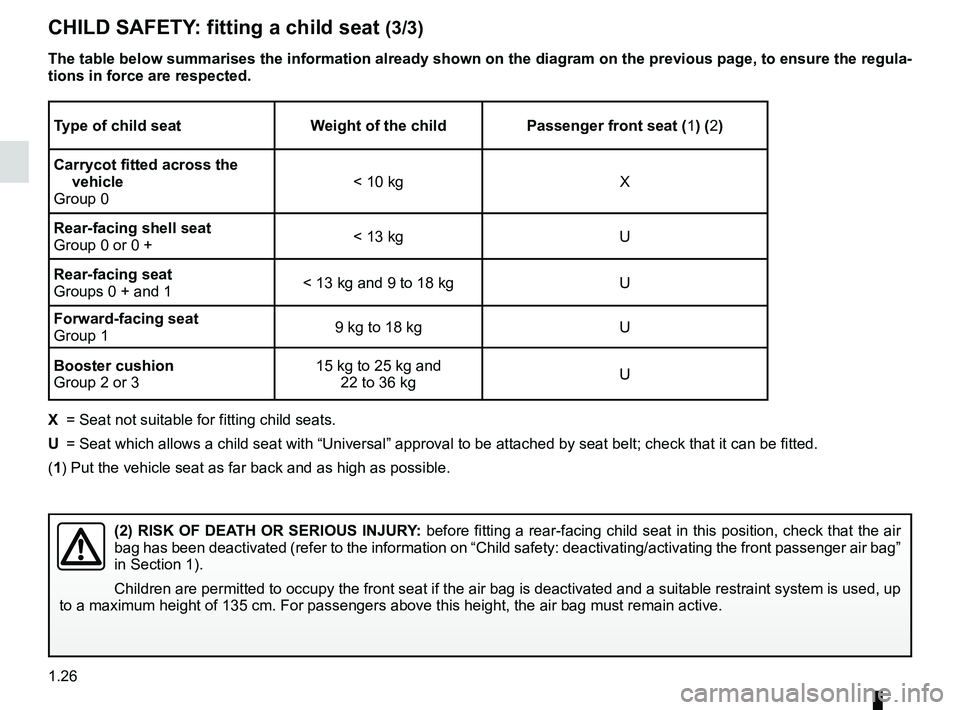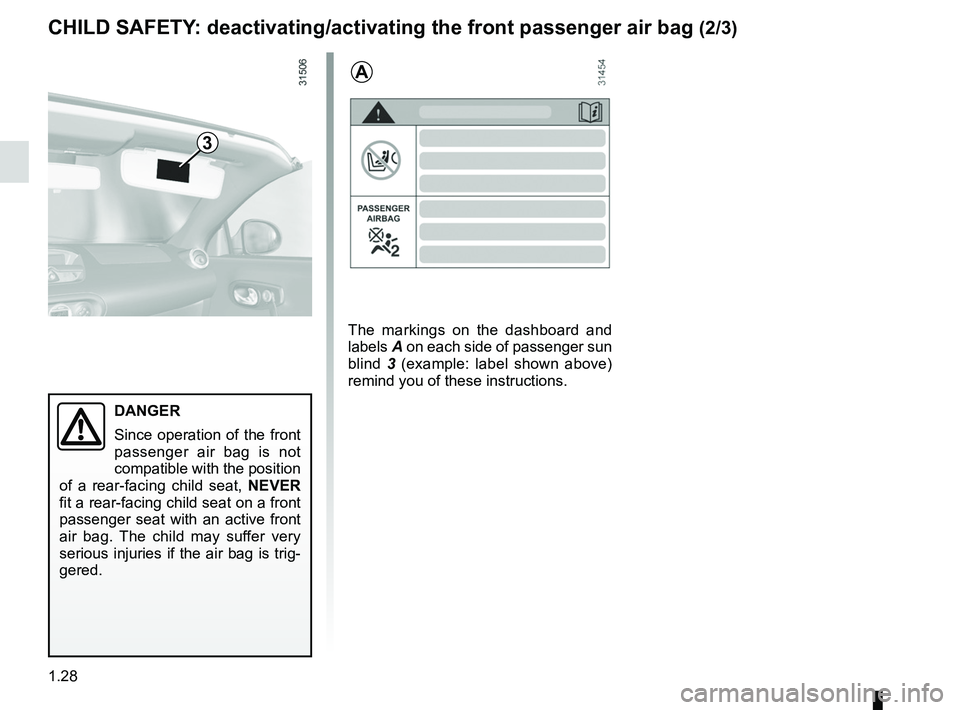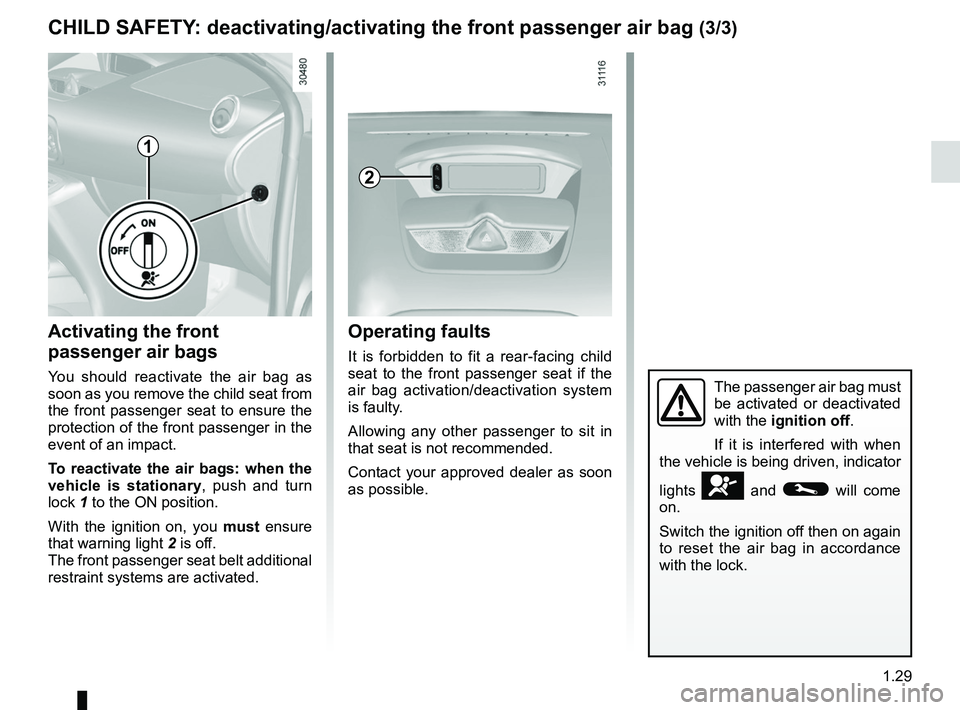2012 RENAULT WIND ROADSTER child seat
[x] Cancel search: child seatPage 30 of 185

child restraint/seat ................................ (up to the end of the DU)
child restraint/seat ................................ (up to the end of the DU)
child restraint/seat ................................ (up to the end of the DU)
child safety ............................................ (up to the end of the DU)
child seats ............................................. (up to the end of the DU)
transporting children ............................. (up to the end of the DU)
1.24
ENG_UD20474_3
Sécurité enfants : installation du siège enfant (E33 - X33 - Renault)
ENG_NU_865-6_E33_Renault_1
Jaune NoirNoir texte
Some seats are not suitable for fitting
child seats. The diagram on the follow -
ing page shows you how to attach a
child seat.
The types of child seats indicated may
not be available. Before using a differ-
ent child seat, check with the manufac-
turer that it can be fitted.
fitting a child seat
CHILD SAFETY : fitting a child seat (1/3)
In the front seat
The laws concerning children travel -
ling in the front passenger seat differ in
every country. Consult the legislation in
force and follow the indications on the
diagram on the following page.
Before fitting a child seat in this seat (if
authorised):
– move the seat as far back as pos-
sible;
– on equipped vehicles, raise the
seat base as far as possible;
– gently tilt the seatback away from
vertical (approximately 25°).
Do not change these settings after the
child seat is installed.
Check that when installing
the child seat in the vehi -
cle it is not at risk of coming
loose from its base.
If you have to remove the headrest,
check that it is correctly stored so
that it does not come loose under
harsh braking or impact.
Always attach the child seat to the
vehicle even if it is not in use so that
it does not come loose under harsh
braking or impact.
RISK OF DEATH OR SERIOUS INJURY: before fitting a rear-facing child
seat in this position, check that the air bag has been deactivated (refer to
the information on “Child safety: deactivating/activating the front passen-
ger air bag” in Section 1).
Children of a maximum height of 135 cm are permitted to occupy the front seat if
the air bag is deactivated and a suitable restraint system is used. For passengers
above this height, the air bag must remain active.
Page 31 of 185

JauneNoirNoir texte
1.25
ENG_UD20474_3
Sécurité enfants : installation du siège enfant (E33 - X33 - Renault)
ENG_NU_865-6_E33_Renault_1
² Seat not suitable for fitting child
seats.³ Check the status of the air bag
before fitting a child seat or allowing a
passenger to use the seat.
Using a child safety system
which is not approved for
this vehicle will not correctly
protect the baby or child.
They risk serious or even fatal injury.
CHILD SAFETY : fitting a child seat (2/3)
Child seat attached using the belt
¬ Seat which allows a child seat
with “Universal” approval to be attached
by a seat belt.
RISK OF DEATH OR SERIOUS INJURY: before fitting a rear-facing child
seat in this position, check that the air bag has been deactivated (refer to
the information on “Child safety: deactivating/activating the front passen-
ger air bag” in Section 1).
Children are permitted to occupy the front seat if the air bag is deactivated and a
suitable restraint system is used, up to a maximum height of 135 cm. For passen -
gers above this height, the air bag must remain active.
Page 32 of 185

1.26
ENG_UD20474_3
Sécurité enfants : installation du siège enfant (E33 - X33 - Renault)
ENG_NU_865-6_E33_Renault_1
CHILD SAFETY : fitting a child seat (3/3)
Type of child seat Weight of the childpassenger front seat (1) (2)
Carrycot fitted across the vehicle
Group 0 < 10 kg
X
Rear-facing shell seat
Group 0 or 0 + < 13 kg
U
Rear-facing seat
Groups 0 + and 1 < 13 kg and 9 to 18 kg
U
Forward-facing seat
Group 1 9 kg to 18 kg
U
Booster cushion
Group 2 or 3 15 kg to 25 kg and
22 to 36 kg U
X = Seat not suitable for fitting child seats.
U = Seat which allows a child seat with “Universal” approval to be attached by seat belt; check that it can be fitted.
(1) Put the vehicle seat as far back and as high as possible.
(2) RISK OF DEATH OR SERIOUS INJURY: before fitting a rear-facing child seat in this position, check that the air
bag has been deactivated (refer to the information on “Child safety: deactivating/activating the front passenger air bag”
in Section 1).
Children are permitted to occupy the front seat if the air bag is deactivated and a suitable restraint system is used, up
to a maximum height of 135 cm. For passengers above this height, the air bag must remain active.
The table below summarises the information already shown on the diagram on the previous page, to ensure the regula-
tions in force are respected.
Page 33 of 185

1.27
ENG_UD21752_3
Sécurité enfants : désactivation/activation airbag passager avant (E33 - X33 - Renault)
ENG_NU_865-6_E33_Renault_1
deactivating/activating the front passenger air bag
The passenger air bag must
be activated or deactivated
with the ignition off .
If it is interfered with when
the vehicle is being driven, indicator
lights
å and © will come
on.
Switch the ignition off then on again
to reset the air bag in accordance
with the lock.
CHILD SAFETY : deactivating/activating the front passenger air bag (1/3)
Deactivating the front
passenger airbags
(on equipped vehicles)
In order to fit a child seat to the front
passenger seat when this is allowed,
you must deactivate the front passen-
ger seat additional restraint devices
(side airbags and, depending on vehi -
cle, front airbags, etc.).
2
To deactivate the air bags: with the
vehicle stationary , push and turn
lock 1 to the OFF position.
With the ignition on, it is essential to
check that warning light 2
¹ is lit
on the central display and, depend -
ing on the vehicle, that the message
“ PASSENGERAIRBAG OFF ” is dis-
played.
This light remains permanently lit to
let you know that you can fit a child
seat.
1
DANGER
Since operation of the front
passenger air bag is not
compatible with the position
of a rear-facing child seat, NEVER
fit a rear-facing child seat on a front
passenger seat with an active front
air bag. The child may suffer very
serious injuries if the air bag is trig-
gered.
Page 34 of 185

1.28
ENG_UD21752_3
Sécurité enfants : désactivation/activation airbag passager avant (E33 - X33 - Renault)
ENG_NU_865-6_E33_Renault_1
Jaune NoirNoir texte
CHILD SAFETY : deactivating/activating the front passenger air bag (2/3)
DANGER
Since operation of the front
passenger air bag is not
compatible with the position
of a rear-facing child seat, NEVER
fit a rear-facing child seat on a front
passenger seat with an active front
air bag. The child may suffer very
serious injuries if the air bag is trig-
gered.
The markings on the dashboard and
labels A on each side of passenger sun
blind 3 (example: label shown above)
remind you of these instructions.
A
3
Page 35 of 185

JauneNoirNoir texte
1.29
ENG_UD21752_3
Sécurité enfants : désactivation/activation airbag passager avant (E33 - X33 - Renault)
ENG_NU_865-6_E33_Renault_1
CHILD SAFETY : deactivating/activating the front passenger air bag (3/3)
The passenger air bag must
be activated or deactivated
with the ignition off.
If it is interfered with when
the vehicle is being driven, indicator
lights
å and © will come
on.
Switch the ignition off then on again
to reset the air bag in accordance
with the lock.
Operating faults
It is forbidden to fit a rear-facing child
seat to the front passenger seat if the
air bag activation/deactivation system
is faulty.
Allowing any other passenger to sit in
that seat is not recommended.
Contact your approved dealer as soon
as possible.
Activating the front
passenger air bags
You should reactivate the air bag as
soon as you remove the child seat from
the front passenger seat to ensure the
protection of the front passenger in the
event of an impact.
To reactivate the air bags: when the
vehicle is stationary , push and turn
lock 1 to the ON position.
With the ignition on, you must ensure
that warning light 2 is off.
The front passenger seat belt additional
restraint systems are activated.
2
1
Page 103 of 185

electric windows ................................... (up to the end of the DU)
child safety ............................................................. (current page)
children (safety) ..................................................... (current page)
sunroof .................................................. (up to the end of the DU)
3.19
ENG_UD24366_2
Lève-vitres électriques (E33 - X33 - Renault)
ENG_NU_865-6_E33_Renault_3
Electric windows
eleCtRiC winDows
operation
With the ignition switched on, press the
switch for the relevant window upwards
to raise it to the desired height.
Press the switch for the window con -
cerned downwards to lower it to the de-
sired height.
From the driver’s seat
1 for the driver’s side;
2 for the front passenger side.
one-touch mode
(lowering the window only)
Press switch 1 or 2 down briefly: the
window will open completely.
Pressing the switch again while the
window is moving will stop its move -
ment.
Avoid resting any objects against a
half-open window: there is a risk that
the electric window winder could be
damaged.
1
Driver’s responsibility
Never leave your vehicle
with the key or remote con-
trol inside and never leave a
child (or a pet) unsupervised, even
for a short while. The reason for this
is that the child may endanger him-
self or others by starting the engine
and activating equipment such as
the window winders or the sunroof.
If any part of the body becomes
trapped, reverse the direction of the
window immediately by pressing the
relevant switch.
Risk of serious injury.
2
operating faults
w indow fails to close and/or battery
disconnected
The system has to be reinitialised:
With the door closed and the ignition
switched on,
– Raise the window fully and keep the
button pressed for 2 seconds after it
has stopped moving.
– Lower the window fully and keep the
button pressed for 2 seconds after it
has stopped moving.
If necessary, contact an authorised
dealer.
i f the window closes or opens jerk -
ily, the system is faulty.
Press the button to close the window as
many times as necessary and contact
an authorised dealer.
Page 179 of 185

7.1
FRA_UD30001_7
Index (E33 - X33 - Renault)
ENG_NU_865-6_E33_Renault_7
AlphAbeticAl index (1/4)
A
ABS .............................................................. 1.35, 2.10 → 2.12
accessories........................................................................ 5.25
accessories socket ............................................................ 3.23
additional methods of restraint .....................1.15 → 1.17, 1.19
side protection ............................................................. 1.18
to the front seat belts ....................................... 1.15 → 1.17
adjusting your driving position ........................................... 1.12
air bag ........................................................... 1.15 → 1.19, 1.35
air conditioning ........................................................ 3.8 → 3.18
air vents ...................................................................... 3.6 – 3.7
anti-corrosion check .............................................. 6.14 → 6.18
anti-corrosion protection ......................................... 4.12 – 4.13
anti-lock braking system: ABS ...............................2.10 → 2.12
antipollution advice .................................................................. 2.6 → 2.8
armrest: front .............................................................................. 3.22
ashtray ............................................................................... 3.23
ASR (traction control) ............................................ 2.10 → 2.12
audible and visual signals .................................................. 1.51
b
batteries ............................................................................. 5.24
battery ................................................................................ 4.11
troubleshooting ................................................. 5.22 – 5.23
bonnet ......................................................................... 4.2 – 4.3
brake fluid ............................................................................ 4.8
bulbs changing .......................................................... 5.14 → 5.16
c
catalytic converter ................................................................ 2.4
central door locking .................................................... 1.5, 1.10
changing a bulb ..................................................... 5.14 → 5.16
changing a wheel ........................................................ 5.7 – 5.8changing gear
...................................................................... 2.5
child restraint/seat ............................. 1.20 – 1.21, 1.23 → 1.26
child safety ................1.2 – 1.3, 1.20 – 1.21, 1.23 → 1.26, 3.19
child seats .......................................... 1.20 – 1.21, 1.23 → 1.26
children ................................... 1.2 – 1.3, 1.6 – 1.7, 1.20 – 1.21
children (safety) ................................................................. 3.19
cigar lighter ........................................................................ 3.23
cleaning: inside the vehicle .............................................. 4.14 – 4.15
outside the vehicle ............................................ 4.12 – 4.13
clock .................................................................................. 1.49
closing the doors ........................................................ 1.6 – 1.7
control instruments ................................................ 1.34 → 1.40
controls .................................................................. 1.30 → 1.33
coolant ........................................................................ 1.38, 4.7
courtesy light ................................................. 3.20, 5.17 – 5.18
courtesy mirrors ................................................................. 3.20
cruise control ......................................................... 2.13 → 2.19
cruise control-speed limiter.................................... 2.13 → 2.19
d
dashboard .............................................................. 1.30 → 1.33
daytime running lights ........................................................ 1.52
demisting rear screen ..................................................................... 3.9
dimensions .......................................................................... 6.4
display ................................................................... 1.34 → 1.39
doors .................................................................. 1.6 – 1.7, 1.10
doors/tailgate ..................................................... 1.6 – 1.7, 1.10
driver’s position ..................................................... 1.30 → 1.37
driving ........................................... 2.2, 2.4 → 2.8, 2.10 → 2.19
driving position settings ............................................................ 1.12 → 1.14
e
electric windows ................................................................ 3.19